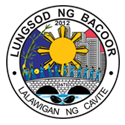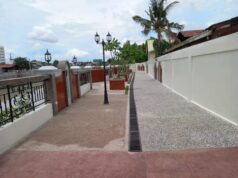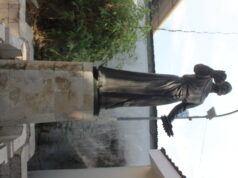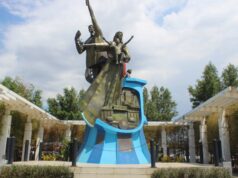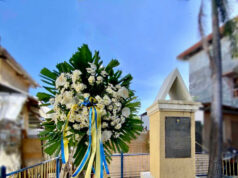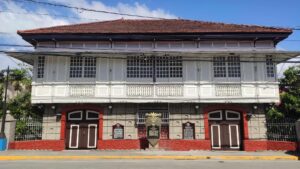
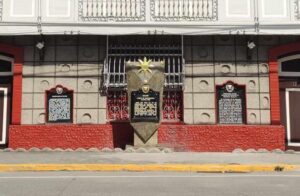
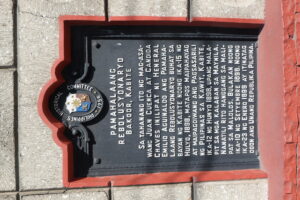
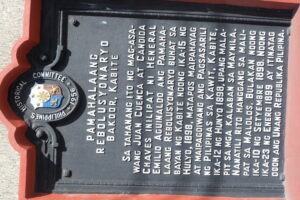
The Cuenca Ancestral House of Bacoor began as a stone house during the era of Don Lorenzo Cuenca who served as Bacoor Gobernadorcillo in 1685. It was a casualty of the 1762 British Invasion of Manila and Cavite when they burned the church and all the houses, farmland, poultry, and livestock in Bacoor. It took the family eight years before its then occupants, Don Simon Cuenca and Doña Manuela Cuenca, were able to rebuild the house. After a century, Don Juan Francisco Cuenca and his wife, Doña Candida Filio Chaves de Cuenca, reconstructed the second floor in its current design and architecture but with a galvanized roof. The tisa roofing was laid in 1892.
In March 1897, the Spanish armed forces of General Jose de Lachambre attempted to burn the Cuenca House after the retaking of Bacoor pueblo from the revolutionaries. Their intention was dissuaded by Doña Marcela Cuenca, daughter of Don Juan and Doña Candida, after she told the soldiers that the house has an oratorio and images of saints that were blessed by the Archbishopric of Manila. She successfully deterred the burning of the house after begging for mercy while holding the family-owned Santo Cristo of Bacoor.
On the 15th of July 1898, the seat of power of Gen. Emilio Aguinaldo’s Gobierno Revolucionario was transferred to the Cuenca House, symbolically making it as the first fully-functioning revolutionary version of Malacañan with four government departments. Along with him was his most trusted adviser, Apolinario Mabini. A few days later, the New York Times reported that “Gen. Aguinaldo has organized the Philippine Cabinet with the following personnel: Gen. Emilio Aguinaldo as President of the Council; Gen. Baldomero Aguinaldo as Secretary of War; Don Leandro Ibarra as Secretary of the Interior; and Gen. Mariano Trias as Secretary of State.” In an article published by the National Magazine in 1910, the Cuenca House was described as “The Birthplace of Philippine Insurrection, where the first meeting of Aguinaldo and his cabinet was held and the Philippine Republic was organized.”
The August 14, 1898 appointment letter that engaged Felipe Buencamino, Gregorio Araneta, Teodoro Sandico and Alejandro Albert to be Aguinaldo’s representatives to the chief of the American Army also emanated from this house. It was the third of three recorded appointments while the Revolutionary Government was stationed in Bacoor. Other significant documents produced while in the Cuenca House include 106 historical documents/letters/telegrams, 3 proclamations, 2 circulars, 2 orders and fourteen presidential and government decrees.
All political and revolutionary activities considered, the most significant historical event that transpired at the Cuenca House was the August 1, 1898 Bacoor Assembly that saw the oathtaking of an estimated 200 town and provincial chiefs, and the signing of Mabini’s Acta de Independencia, an act of Solemn Declaration of Independence by the Filipino People. It was signed by representatives from Cavite, Pampanga, Manila, Bulacan, Bataan, Nueva Ecija, La Laguna, Morong, Tarlac, Batangas, Mindoro, Tayabas, Zambales, Pangasinan, Union, and Infanta. Everything that occurred at the Cuenca House of Bacoor directly contributed to the events that transpired in Malolos, Bulacan, making it an integral silent witness to our country’s path to nationhood.
On a religious perspective, the Cuenca House served as the venue for the celebration of masses and holy sacraments when the Roman Catholic Church was transferred here during the Aglipayan Schism from 1902 to 1907. It was a time of great concern for the Roman Catholics of Bacoor as only eight families remained in the fold, out of a population of almost 11,000 Bacooreños.
In 1956, it was declared as a historical structure by the Philippine Historical Committee in its Pamahalaang Rebolusyonaryo marker. The gradual restoration of the house began in 1972 as advocated by Don Juan Cuenca’s namesake and grandson, Juan C. Cuenca, and his wife, Soledad J. Advincula-Cuenca.
In the 21st century, the Cuenca Ancestral House was declared as Mahalagang Yamang Pangkalinangan ng Pilipinas (Important Cultural Property) by the National Museum of the Philippines on 28 December 2020. Its marker was unveiled two years later.
Noteworthy to mention is the recommendation of former Chairman Rene R. Escalante of the National Historical Commission of the Philippines to relocate the Pagpupulong sa Bacoor marker from the Plaza de Padre Mariano Gomes to the Cuenca House. His recommendation states that “the Cuenca House is a more appropriate site due to its role as headquarters of the Philippine Revolutionary Government.”
Moreover, the Cuenca House was also included by the Philippine Postal Corporation in its Kalayaan ay Pamana stamp series launched on May 4, 2023. Together with seven others, it was described as “as one of the eight heritage structures directly associated with the birth of the Filipino nation, the first democracy and constitutional republic in the whole of Asia.”
After more than a month, the National Archives of the Philippines included this Bacoor treasure in their June 16, 2023 exhibit “Pitong Kanlungan ng Kasarinlan: Mga Unang Punongbayan ng Gobyernong Rebolusyonaryo at ng Unang Republika ng Pilipinas.”
Finally, as the country began to celebrate the 125th Anniversary of Philippine Independence and Nationhood 2023-2026, the privately-owned Cuenca House of Bacoor became the very first heritage structure among an estimated 100 sites nationwide to unveil the National Historical Commission of the Philippines’ “Landas ng Pagkabansang Pilipino” marker trail.
Ang Bahay na Tisa ng Pamilya Cuenca is privately-owned by the Cuenca family. It is not open to the public.
How to get there: https://maps.app.goo.gl/VBX5abMCvexdSBVQ9
